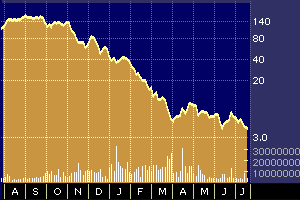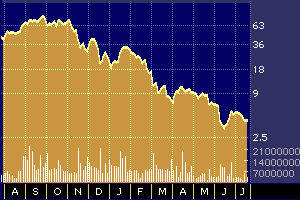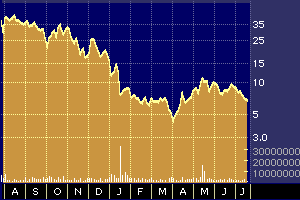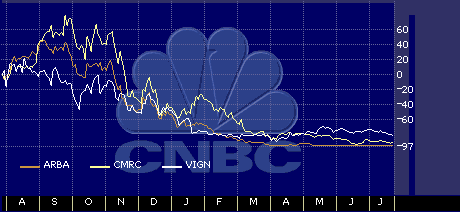
Investors Curious About XML Bandwagon
Investors Curious About XML Bandwagon
by Hal Plotkin
Silicon Valley Correspondent
The language of business in the next decade may not be English but a new version of the lingo that powers today’s Internet. Already, some publicly traded companies — and their stocks — are cashing in on the hype.
Soaring stock prices of companies such as Ariba Inc. {ARBA}, Commerce One Inc. {CMRC}, and Vignette Corp. {VIGN} reflect strong investor confidence in XML — the next generation of the HTML programming language used by Internet browsers such as Microsoft Explorer and Netscape Communicator.
XML, however, improves on HTML by allowing Internet publishers to fine-tune their products for wider use by consumers and businesses.
“There doesn’t seem to be any part of the computer industry that XML won’t apply to,” says Lisa Rein, a contributing editor at XML.com, a leading online source of XML news and information.
The XML wave, which is expected to eventually influence the entire high-tech sector, is already having a significant impact on business-to-business e-commerce markets.
Earlier this week, for example, Sunnyvale, Calif.-based Ariba, one of the leading XML-focused companies, reported fourth-quarter sales rose 266 percent to $17.1 million and reported a loss of 7 cents a share, 5 cents narrower than analysts expected. Ariba shares jumped to 180 from 166.31 on the news.
Although the company lost $4.6 million over the same period, the rapid growth in revenue, along with Ariba’s position as an early XML leader, helps explain why the stock has risen more than 600 percent in the past few months.
Ariba uses a form of XML technology to link more than 20,000 suppliers with more than 50 major buyers who have combined purchasing power in excess of $140 billion. The firm’s current clients include Advanced Micro Devices Inc. {AMD} Cisco Systems Inc. {CSCO}, and Hewlett-Packard Co. {HWP}.
Ariba Inc. {ARBA}

ARBA Post-IPO Stock Performance Chart
“Several of the XML companies are already doing very well,” Rein says. “What’s exciting is we’re just at the beginning. There’s lots more to come.”
One of Ariba’s arch rivals, Walnut Creek, Calif.-based Commerce One, said earlier this week that more than 40 customer buyers and 5,000-plus suppliers are now participating in its MarketSite.net business-to-business portal.
Like Ariba, Commerce One’s stock price is also up more than 300 percent over the past three months, reflecting the growing tide of interest in XML.
“We’re giving every business the kind of purchasing power that only the largest companies used to have,” says Mike Micucci, Commerce One’s director of product marketing. “XML is absolutely critical to giving us the economies of scale that creates the network effect.” Commerce One customer/buyers include BellSouth Corp. {BLS}, PepsiCo Inc. {PEP}, Pitney Bowes Inc. {PBI}, Siemens {SMAWY}, Warner Lambert Co. {WLA}, and Wells Fargo & Co. {WFC}.
Commerce One, Inc. {CMRC}

CMRC Post-IPO Stock Performance Chart
Varda Lief, an analyst Forrester Research, based in Framingham, Mass., says Commerce One’s marketing approach will position the company as an even more-formidable contender in the future. Commerce One “has the winning solution,” Lief wrote in a recent research report.
More specifically, Commerce One’s strategy involves publishing freely available XML-based business documents on the Web, such as catalog formats, invoices, and purchase orders, which businesses can use to participate in the purchasing network.
“Our model is about making it as easy as possible to conduct business with as wide a variety of customers as possible,” Micucci says. Commerce One is also developing an auction model, similar to eBay.com, designed specifically for businesses.
Like Ariba and Commerce One, the ascendancy of Austin, Texas-based Vignette Corp. also illustrates the movement of XML companies to center stage.
Although the company’s chart resembles a roller coaster, Vignette’s stock has moved up quite sharply since the company went public last February at $19 a share, topping $115 earlier this week.
Vignette Corporation {VIGN}

VIGN Ppost-IPO Stock Performance Chart
Vignette’s stock jumped more than $10 Wednesday after the company said that revenue for the fiscal second quarter ended Sept. 30 increased by 459 percent to $24.2 million.
The competition between companies such as Ariba, Commerce One, and Vignette, heated as it may be, is still very much in its early stages.

Four-Month Comparison Chart: ARBA, CMRC, VIGN
Overall, the market for companies that connect business buyers with sellers is expected to top $1.3 trillion by 2003, according to a recent estimate by Forrester Research. How well companies implement XML is expected to be one of the key drivers of future success for companies competing in that market.
Several major firms, including IBM {IBM}, Microsoft Corp. {MSFT}, Oracle Corp. {ORCL}, and Sun Microsystems Inc. {SUNW} are already backing XML, based upon a W3C XML standard published in February of last year. Microsoft president Steve Ballmer, for example, recently said XML would be the “secret sauce” in future version’s of Microsoft software.
Although some technical details are still being hammered out, such as how XML will standardize the handling of graphics, industry insiders say strong sales at Ariba, Commerce One, and Vignette are indications the technology is already taking off.
Chris Silva, associate research analyst at International Data Corp., based in Framingham, Mass., shares the enthusiasm for XML.
“XML is going to be the answer for medium and small businesses where EDI was the answer for large businesses,” Silva says. “Your going to see a shift from point-to-point networks to one-to-many networks based on non-proprietary standards.”
Silva says he doesn’t think any remaining XML standards-based issues will hold the sector back. “A lot of the warring XML factions have come together,” he adds. “The emerging standard for XML in the business-to-business space incorporates the best aspects of the XML standards in the market today.”
When Microsoft jumped on the XML bandwagon last summer, the company published a white paper detailing XML’s potential in a variety of business settings, including customer-service operations, and e-commerce vendors, and financial services.
Besides boosting the stocks of early XML leaders, XML could also pose serious problems for companies that don’t adapt to the new technology fast enough.
First-generation online retailers, for example, could be hit particularly hard by XML competitors that offer more-comprehensive, personalized online shopping services.
XML.com’s Rein says investors should take a hard look at their high-tech stock holdings and make sure those companies have clear and aggressive XML strategies.
“Look for white papers on their Web sites, ask questions,” she says. In particular, Rein says, make sure companies are using technology that is XML 1.0 compliant, rather than their own proprietary flavor of the language, which would cut a company off from the larger standards-based XML community.
And don’t be fooled by companies that spout XML lingo but aren’t clear or precise about how XML will help them better serve targeted markets.
“You want to know how the company plans to use XML,” Rein says. “Then you can decide for yourself if what they plan to do will keep them competitive.”
Some of the most prominent of the dozens of XML companies in the pre-IPO pipeline include Waltham, Mass.-based Arbortext Inc.; Softquad Software Inc., based in Toronto; and Chrystal Software, a Xerox Corp. {XRX} new enterprise company based in San Diego.


